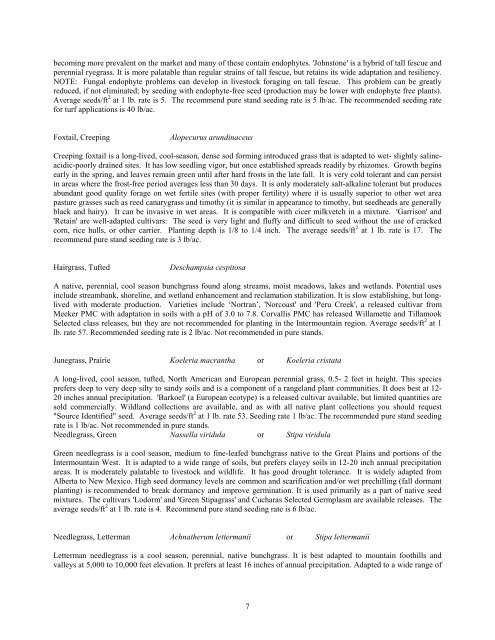Idaho Plant Materials Technical Note No. 24
Idaho Plant Materials Technical Note No. 24
Idaho Plant Materials Technical Note No. 24
Create successful ePaper yourself
Turn your PDF publications into a flip-book with our unique Google optimized e-Paper software.
ecoming more prevalent on the market and many of these contain endophytes. 'Johnstone' is a hybrid of tall fescue and<br />
perennial ryegrass. It is more palatable than regular strains of tall fescue, but retains its wide adaptation and resiliency.<br />
NOTE: Fungal endophyte problems can develop in livestock foraging on tall fescue. This problem can be greatly<br />
reduced, if not eliminated; by seeding with endophyte-free seed (production may be lower with endophyte free plants).<br />
Average seeds/ft 2 at 1 lb. rate is 5. The recommend pure stand seeding rate is 5 lb/ac. The recommended seeding rate<br />
for turf applications is 40 lb/ac.<br />
Foxtail, Creeping<br />
Alopecurus arundinaceus<br />
Creeping foxtail is a long-lived, cool-season, dense sod forming introduced grass that is adapted to wet- slightly salineacidic-poorly<br />
drained sites. It has low seedling vigor, but once established spreads readily by rhizomes. Growth begins<br />
early in the spring, and leaves remain green until after hard frosts in the late fall. It is very cold tolerant and can persist<br />
in areas where the frost-free period averages less than 30 days. It is only moderately salt-alkaline tolerant but produces<br />
abundant good quality forage on wet fertile sites (with proper fertility) where it is usually superior to other wet area<br />
pasture grasses such as reed canarygrass and timothy (it is similar in appearance to timothy, but seedheads are generally<br />
black and hairy). It can be invasive in wet areas. It is compatible with cicer milkvetch in a mixture. 'Garrison' and<br />
'Retain' are well-adapted cultivars: The seed is very light and fluffy and difficult to seed without the use of cracked<br />
corn, rice hulls, or other carrier. <strong>Plant</strong>ing depth is 1/8 to 1/4 inch. The average seeds/ft 2 at 1 lb. rate is 17. The<br />
recommend pure stand seeding rate is 3 lb/ac.<br />
Hairgrass, Tufted<br />
Deschampsia cespitosa<br />
A native, perennial, cool season bunchgrass found along streams, moist meadows, lakes and wetlands. Potential uses<br />
include streambank, shoreline, and wetland enhancement and reclamation stabilization. It is slow establishing, but longlived<br />
with moderate production. Varieties include ‘<strong>No</strong>rtran’, '<strong>No</strong>rcoast' and 'Peru Creek', a released cultivar from<br />
Meeker PMC with adaptation in soils with a pH of 3.0 to 7.8. Corvallis PMC has released Willamette and Tillamook<br />
Selected class releases, but they are not recommended for planting in the Intermountain region. Average seeds/ft 2 at 1<br />
lb. rate 57. Recommended seeding rate is 2 lb/ac. <strong>No</strong>t recommended in pure stands.<br />
Junegrass, Prairie Koeleria macrantha or Koeleria cristata<br />
A long-lived, cool season, tufted, <strong>No</strong>rth American and European perennial grass, 0.5- 2 feet in height. This species<br />
prefers deep to very deep silty to sandy soils and is a component of a rangeland plant communities. It does best at 12-<br />
20 inches annual precipitation. 'Barkoel' (a European ecotype) is a released cultivar available, but limited quantities are<br />
sold commercially. Wildland collections are available, and as with all native plant collections you should request<br />
"Source Identified" seed. Average seeds/ft 2 at 1 lb. rate 53. Seeding rate 1 lb/ac. The recommended pure stand seeding<br />
rate is 1 lb/ac. <strong>No</strong>t recommended in pure stands.<br />
Needlegrass, Green Nassella viridula or Stipa viridula<br />
Green needlegrass is a cool season, medium to fine-leafed bunchgrass native to the Great Plains and portions of the<br />
Intermountain West. It is adapted to a wide range of soils, but prefers clayey soils in 12-20 inch annual precipitation<br />
areas. It is moderately palatable to livestock and wildlife. It has good drought tolerance. It is widely adapted from<br />
Alberta to New Mexico. High seed dormancy levels are common and scarification and/or wet prechilling (fall dormant<br />
planting) is recommended to break dormancy and improve germination. It is used primarily as a part of native seed<br />
mixtures. The cultivars 'Lodorm' and 'Green Stipagrass' and Cucharas Selected Germplasm are available releases. The<br />
average seeds/ft 2 at 1 lb. rate is 4. Recommend pure stand seeding rate is 6 lb/ac.<br />
Needlegrass, Letterman Achnatherum lettermanii or Stipa lettermanii<br />
Letterman needlegrass is a cool season, perennial, native bunchgrass. It is best adapted to mountain foothills and<br />
valleys at 5,000 to 10,000 feet elevation. It prefers at least 16 inches of annual precipitation. Adapted to a wide range of<br />
7
















